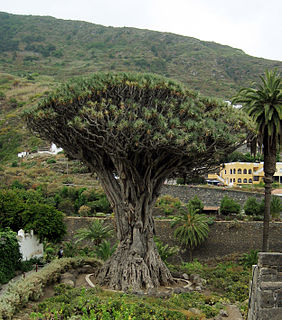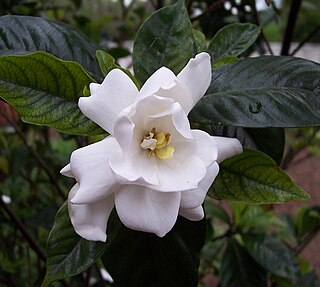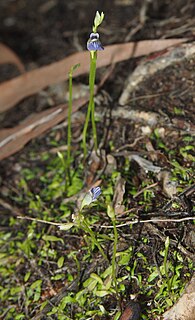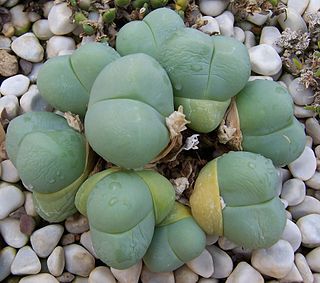
Cortaderia is a genus of South American and Central American plants in the Poaceae grass family.

The Aizoaceae, or fig-marigold family, is a large family of dicotyledonous flowering plants containing 135 genera and about 1800 species. They are commonly known as ice plants or carpet weeds. They are often called vygies in South Africa and New Zealand. Highly succulent species that resemble stones are sometimes called mesembs.

Dracaena is a genus of about 120 species of trees and succulent shrubs. The formerly accepted genera Pleomele and Sansevieria are now included in Dracaena. In the APG IV classification system, it is placed in the family Asparagaceae, subfamily Nolinoideae. It has also formerly been separated into the family Dracaenaceae or placed in the Agavaceae.

Gardenia is a genus of flowering plants in the coffee family, Rubiaceae, native to the tropical and subtropical regions of Africa, Asia, Madagascar and Pacific Islands, and Australia.

Gaultheria is a genus of about 135 species of shrubs in the family Ericaceae. The name commemorates Jean François Gaultier of Quebec, an honour bestowed by the Scandinavian Pehr Kalm in 1748 and taken up by Carl Linnaeus in his Species Plantarum. These plants are native to Asia, Australasia and North and South America. In the past, the Southern Hemisphere species were often treated as the separate genus Pernettya, but no consistent reliable morphological or genetic differences support recognition of two genera, and they are now united in the single genus Gaultheria.

Digitaria is a genus of plants in the grass family native to tropical and warm temperate regions but can occur in tropical, subtropical, and cooler temperate regions as well. Common names include crabgrass, finger-grass, and fonio. They are slender monocotyledonous annual and perennial lawn, pasture, and forage plants; some are often considered lawn pests. Digitus is the Latin word for "finger", and they are distinguished by the long, finger-like inflorescences they produce.

Adenium is a genus of flowering plants in the family Apocynaceae first described as a genus in 1819. It is native to Africa and the Arabian Peninsula.

Patersonia, commonly known as native iris or native flag and are native to areas from Malesia to Australia.

Utricularia caerulea, the blue bladderwort, is a very small to medium-sized carnivorous plant that belongs to the genus Utricularia. U. caerulea spans a wide native range, including areas in tropical Africa, Asia, and Australia. It grows as a terrestrial plant in wet, shallow soils over rock, in wet grasslands, in swamps, or near streams in open communities, mostly at lower altitudes but ascending to as much as 2,100 m (6,890 ft). It was originally described and published by Carl Linnaeus in 1753.
Ephedra alata is a species of Ephedra. These plants are perennial and xerophytic gymnosperm shrubs.

Gibbaeum is a genus of about 21 species of small succulent plants of the family Aizoaceae, indigenous to the Little Karoo region of South Africa. The name "Gibbaeum" comes from the Latin gibbosus (hunchback)
Rhytachne is a genus of plants in the grass family. They grow principally in wet savannahs in Africa and the Americas. More specifically, they tend to prefer transitional zones between marshes and drier upland savannahs. In the Americas the genus can be found from southern Mexico and Cuba south to northern Argentina, while in Africa it is present below the Sahara, including in Madagascar. Twelve species are included, of which nine are African, two are American, and one, Rhytachne subgibbosa, is found on both continents. The genus is closely related to Coelorachis.

Sonerila is a genus of plants in the family Melastomataceae. This genus is characterized the by presence of three petals as opposed to five in the other members of the family. Most members of the genus prefer growing in shady habitats. It is a large genus including about 175 species.

Protea foliosa, also known as the leafy sugarbush, is a flowering plant of the genus Protea in the family Proteaceae which is endemic to the Cape Region of South Africa. In the Afrikaans language it is known as ruie-suikerbos.

Pterodiscus is a genus of plant in the Pedaliaceae family comprising several species with a native range from Ethiopia to S. Africa. The range passes through the countries of Angola, Botswana,, Ethiopia, Kenya, Mozambique, Namibia, Somalia, Sudan, Tanzania, Zambia and Zimbabwe. Plus it is found also within the Provinces of South Africa in Cape Provinces, Free State, KwaZulu-Natal and Northern Provinces.













